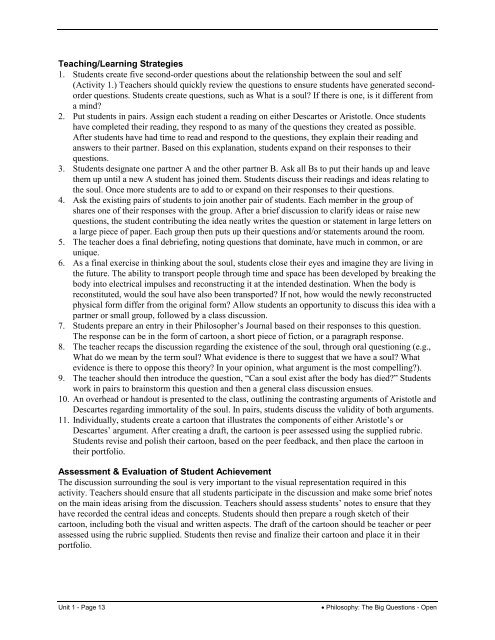Course Profile - Curriculum Services Canada
Course Profile - Curriculum Services Canada
Course Profile - Curriculum Services Canada
You also want an ePaper? Increase the reach of your titles
YUMPU automatically turns print PDFs into web optimized ePapers that Google loves.
Teaching/Learning Strategies<br />
1. Students create five second-order questions about the relationship between the soul and self<br />
(Activity 1.) Teachers should quickly review the questions to ensure students have generated secondorder<br />
questions. Students create questions, such as What is a soul? If there is one, is it different from<br />
a mind?<br />
2. Put students in pairs. Assign each student a reading on either Descartes or Aristotle. Once students<br />
have completed their reading, they respond to as many of the questions they created as possible.<br />
After students have had time to read and respond to the questions, they explain their reading and<br />
answers to their partner. Based on this explanation, students expand on their responses to their<br />
questions.<br />
3. Students designate one partner A and the other partner B. Ask all Bs to put their hands up and leave<br />
them up until a new A student has joined them. Students discuss their readings and ideas relating to<br />
the soul. Once more students are to add to or expand on their responses to their questions.<br />
4. Ask the existing pairs of students to join another pair of students. Each member in the group of<br />
shares one of their responses with the group. After a brief discussion to clarify ideas or raise new<br />
questions, the student contributing the idea neatly writes the question or statement in large letters on<br />
a large piece of paper. Each group then puts up their questions and/or statements around the room.<br />
5. The teacher does a final debriefing, noting questions that dominate, have much in common, or are<br />
unique.<br />
6. As a final exercise in thinking about the soul, students close their eyes and imagine they are living in<br />
the future. The ability to transport people through time and space has been developed by breaking the<br />
body into electrical impulses and reconstructing it at the intended destination. When the body is<br />
reconstituted, would the soul have also been transported? If not, how would the newly reconstructed<br />
physical form differ from the original form? Allow students an opportunity to discuss this idea with a<br />
partner or small group, followed by a class discussion.<br />
7. Students prepare an entry in their Philosopher’s Journal based on their responses to this question.<br />
The response can be in the form of cartoon, a short piece of fiction, or a paragraph response.<br />
8. The teacher recaps the discussion regarding the existence of the soul, through oral questioning (e.g.,<br />
What do we mean by the term soul? What evidence is there to suggest that we have a soul? What<br />
evidence is there to oppose this theory? In your opinion, what argument is the most compelling?).<br />
9. The teacher should then introduce the question, “Can a soul exist after the body has died?” Students<br />
work in pairs to brainstorm this question and then a general class discussion ensues.<br />
10. An overhead or handout is presented to the class, outlining the contrasting arguments of Aristotle and<br />
Descartes regarding immortality of the soul. In pairs, students discuss the validity of both arguments.<br />
11. Individually, students create a cartoon that illustrates the components of either Aristotle’s or<br />
Descartes’ argument. After creating a draft, the cartoon is peer assessed using the supplied rubric.<br />
Students revise and polish their cartoon, based on the peer feedback, and then place the cartoon in<br />
their portfolio.<br />
Assessment & Evaluation of Student Achievement<br />
The discussion surrounding the soul is very important to the visual representation required in this<br />
activity. Teachers should ensure that all students participate in the discussion and make some brief notes<br />
on the main ideas arising from the discussion. Teachers should assess students’ notes to ensure that they<br />
have recorded the central ideas and concepts. Students should then prepare a rough sketch of their<br />
cartoon, including both the visual and written aspects. The draft of the cartoon should be teacher or peer<br />
assessed using the rubric supplied. Students then revise and finalize their cartoon and place it in their<br />
portfolio.<br />
Unit 1 - Page 13<br />
• Philosophy: The Big Questions - Open
















